|
|
||||

Upper Peninsula Forestry
 AUTO TOUR !
AUTO TOUR !
This U.P. Forestry
Auto Tour is sponsored by the Michigan Society of American Foresters and the
Michigan Sustainable Forestry InitiativeSM. Brochures are available
at a number of locations in the U.P., including ![]() Michigan Visitor Centers and Michigan
State University County Extension offices. Now, this tour is best done
while travelling through the 8.7 million-acre U.P. forest. However, this
page will describe what to expect. Watch for the sign posts with the numbered SAF shields. There are 121 sites labeled on the brochure map with more
added on a regular basis. If you would like the brochure mailed to you,
try calling MSU Extension at 906-786-1575, any U.P. County Extension office,
or email your request. And, welcome
to the U.P.!
Michigan Visitor Centers and Michigan
State University County Extension offices. Now, this tour is best done
while travelling through the 8.7 million-acre U.P. forest. However, this
page will describe what to expect. Watch for the sign posts with the numbered SAF shields. There are 121 sites labeled on the brochure map with more
added on a regular basis. If you would like the brochure mailed to you,
try calling MSU Extension at 906-786-1575, any U.P. County Extension office,
or email your request. And, welcome
to the U.P.!
MSAF
Home Page
Lower Peninsula Auto Tour
|
The Sites |
||
INTRODUCTION
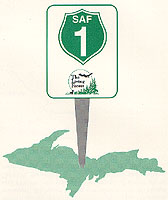 From the Society of
American Foresters, WELCOME to Michigan’s Upper Peninsula (U.P.)! Throughout
this self-guided auto tour, we hope to help you enjoy all that the U.P. has
to offer.
From the Society of
American Foresters, WELCOME to Michigan’s Upper Peninsula (U.P.)! Throughout
this self-guided auto tour, we hope to help you enjoy all that the U.P. has
to offer.
There are more than 19.3 million forested acres in Michigan, with 8.7 million acres in the U.P. With that much area covered by trees, it is no wonder that the forest industry is an integral part of the Upper Peninsula economy! Michigan timber contributes over $8 million and 178,000 jobs statewide, nine percent of which are in the U.P., through forest-based corporations and tourism/recreation. These numbers will vary with differing analyses, but the main message is that these industries are essential to the economy, forest health, and lifestyles of the U.P.
Private individuals own approximately 30 percent of the timberland in the U.P. Maple, beech, and birch, the typical hardwood stand, make up the majority of all timberland in the U.P. Some of the other key forest types are aspen and northern white cedar. Aspen is vital to paper production and hardwoods are used for a variety of products. Cedar also has important uses for both humans and animals.
This tour is designed to guide you through this vast land of changing terrain and to assist the traveler in learning about our beautiful and productive forests. In this brochure you will read about the species types that we, as foresters in the U.P., manage for timber, recreation and ecological values. With a brief exposure to jack pine, for example, you will find corresponding numbers on the map where you can view a jack pine stand. As you travel on U.P. road ways, you will see road signs with our distinctive SAF/SFI logo and a number that corresponds to your map. Take a moment as you drive by that particular site to ponder the wonderful visual, economic, and recreational value of timberland, not only in the U.P. but worldwide.
If you would like more information on the Society of American Foresters, please contact SAF National Headquarters at www.safnet.org or 301-897-8720. Enjoy your tour!
 |
SOCIETY OF AMERICAN FORESTERS The mission of the Michigan Society of American Foresters is responsible stewardship of our forests while meeting the vital needs of society. The Michigan SAF website is http://forestry.msu.edu/msaf, or call 301-897-8720. |
 |
SUSTAINABLE FORESTRY INITIATIVE The mission of the SFI is to promote a stewardship ethic on all forest lands that ensure conservation and enhancement of water quality, fish, and wildlife habitat, and healthy forests while providing for the forest products needs of society. |
|
|
FOREST INDUSTRY Michigan has a vast and diverse forest resource that allows for a vital forest industry. Timberland acreage in Michigan is the fifth largest in the United States. We have 18.6 million acres of timberland in this state. In the Upper Peninsula, 1,513,500 acres, or 8% of timberland are owned by forest industry companies such as Plum Creek and The ForestLand Group. This vast acreage is well managed by trained forestry professionals, to provide a continuing timber supply to regional mills and buyers. The forest industry owns various types of forests throughout the Upper Peninsula and most of its activities are visible as you drive along the major highways. Some of the larger and more visible mills that utilize the forests of the Upper Peninsula are: Louisiana-Pacific (Sagola and Newberry), Potlatch (Sawyer), NewPage (Escanaba), Timber Products (Munising), Verso Paper(Quinnesec), Manistique Papers (Manistique), and Smurfit-Stone (Ontonagon). Many other mills can be spotted as you travel throughout the U.P. Most of these mills are members of the Sustained Forest Initiative. Almost every town in the U.P., large and small, has a mill or other business that uses raw materials from our forests. Transporting products to the industrial sites can be costly in this large state and most of the companies heavily utilize the railways and roadways. Almost every small town in the Upper Peninsula is primarily supported by the forest industry, so it plays a vital role in our economy. |
 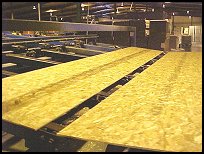 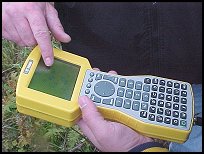 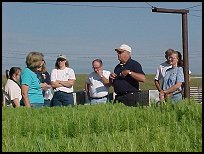 |
RECREATION
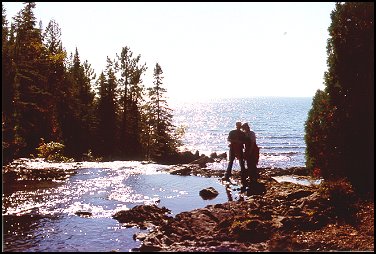 Michigan’s
Upper Peninsula forests offer a wide range of recreation opportunities. State
and federal lands are open all year for everyone to enjoy. Year-round
activities attract people from all over the world to the U.P. The abundance
of these open lands in the U.P. allow for endless snowmobile and cross-country
ski trails. We have some of the best groomed snowmobile trails in the
Midwest. Many championship cross-country ski races are held here during
the winter, drawing competitors from as far away as Europe. During the
warmer months, fishing, hiking, camping, hunting, bird watching, and ecological
studies abound, made possible by our vast forests and their inherent values.
Michigan’s
Upper Peninsula forests offer a wide range of recreation opportunities. State
and federal lands are open all year for everyone to enjoy. Year-round
activities attract people from all over the world to the U.P. The abundance
of these open lands in the U.P. allow for endless snowmobile and cross-country
ski trails. We have some of the best groomed snowmobile trails in the
Midwest. Many championship cross-country ski races are held here during
the winter, drawing competitors from as far away as Europe. During the
warmer months, fishing, hiking, camping, hunting, bird watching, and ecological
studies abound, made possible by our vast forests and their inherent values.
Due to sound forest management, we have an abundance of native animals. Moose have been re-established in the Upper Peninsula. Year after year, record numbers of white-tailed deer attract hunters, boosting the economy of many small towns around the U.P.
Some of the key tourist spots in the U.P. are the Soo Locks in Sault Ste. Marie, Tahquamenon Falls near Paradise, Pictured Rocks National Lakeshore in Munising, Brockway Mountain in the Keweenaw Peninsula, the Porcupine Mountains in Ontonagon County, and the iron and copper mines of Marquette and Houghton.
No matter what your reason to visit the U.P., the forests offer many year-round activities.
WETLANDS
Wetlands are fascinating and complex ecosystems that perform a variety of functions of vital importance to the environment. They can be classified into 3 broad categories; marshes, shrub wetlands, and forested wetlands. Wetlands regulate water flow by detaining storm flows for short periods thus reducing flood peaks. Wetlands protect lake shore and coastal areas by buffering the erosive action of waves and other storm effects. Wetlands improve water quality by retaining or transforming excess nutrients and by trapping sediment and heavy metals. Wetlands provide many wildlife habitat components such as breeding grounds, nesting sites, and other critical habitat for a variety of fish and wildlife species, as well as the special habitat requirements of many threatened and endangered plants and animals. Wetlands also provide a bounty of plant and animal products such as blueberries, cranberries, timber, fiber, fin fish, shellfish, waterfowl, furbearers, and game animals.
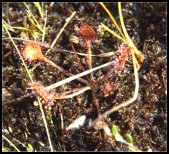 |
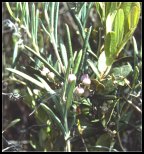 |
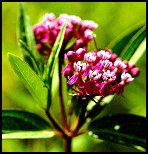 |
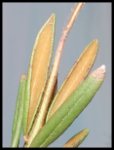 |
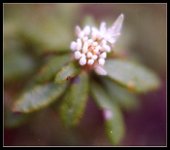 |
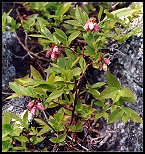 |
| Sundew | Bog Rosemary | Marsh Milkweed | Labrador Tea | Leatherleaf | Blueberry |
TREE FARM SYSTEM
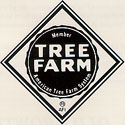 The American Tree Farm Systemis a nation-wide
community of nearly 60,000 landowners linked by a desire to manage their woodlands
effectively. Effective management includes producing continuous crops
of trees to supply our nation’s wood products needs, and simultaneously
maintaining the forest to be aesthetically pleasing and beneficial to wildlife. A
Tree Farm might be a plantation. However, most Tree Farms are natural forests
managed for a variety of outcomes.
The American Tree Farm Systemis a nation-wide
community of nearly 60,000 landowners linked by a desire to manage their woodlands
effectively. Effective management includes producing continuous crops
of trees to supply our nation’s wood products needs, and simultaneously
maintaining the forest to be aesthetically pleasing and beneficial to wildlife. A
Tree Farm might be a plantation. However, most Tree Farms are natural forests
managed for a variety of outcomes.
Tree farmers play a critical role in our nation’s economy. Fully 58 percent of all timber harvested in the United States comes from the non-industrial private woodlands, that is, land owned by individuals, not the government or timber companies. Tree Farms play a valuable role as well, providing wildlife habitat and watershed protection and often offering recreational opportunities for members of the community.
Tree farmers generally own a minimum of 10 acres of forest land. To qualify, they must have their land inspected by one of the 10,000 foresters who donate their time to the Tree Farm system. Lands are re-inspected at least every five years to assure that they are properly managed.
The American Tree Farm System is run on the state level by state Tree Farm committees. It is a program of the American Forest Foundation, administered by the American Forest Council in Washington, D.C. Funding for the program comes from private donations and contributions from the forest products industry.
| ASPEN
- 7 Sites
Aspen are opportunists. They commonly take over disturbed areas by sprouting from the roots of mature trees. With full sunlight after a disturbance (logging, fire, wind damage), aspen will aggressively sprout into a thicket of new trees. Because they are nourished by a large, established root system, they can grow three to four feet in just the first season, easily outdoing their competitors. Aspen also reproduces by seed. Of interest is that an aspen tree is either male or female. That is a tree that will produce only male flowers (pollen) or female flowers (for seed). Aspen grows fast but has a short life span of 60-80 years. Unless a disturbance is created, it dies and the forest changes to other types of trees. That is why you may see clearcut logging in aspen forest. This cutting provides the conditions to regenerate the aspen forest and begin the cycle all over again. Aspen is a major forest cover type in Michigan. The harvested trees are used for a wide variety of products including paper, pallets, lumber and particleboard.
|
 Aspen Clone |
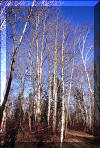 Aspen Poles |
WHITE BIRCH - 6 Sites
![]() White Birch is one of the most striking native
North American trees. Birch is important for both its aesthetic value and wood
products. Birch clumps are often formed from stump sprouts, making it easy to
see and adding contrast and variety to the landscape.
White Birch is one of the most striking native
North American trees. Birch is important for both its aesthetic value and wood
products. Birch clumps are often formed from stump sprouts, making it easy to
see and adding contrast and variety to the landscape.
Most white birch is harvested for pulpwood because of its small size. However, due to its white sapwood, straight grain and smooth texture, white birch can produce a quality timber product. These include veneer logs, sawlogs, and sawbolts which are made into ice cream sticks, tongue depressors, paint stir sticks, toothpicks, dowels, clothespins, etc.
White birch is a short-lived, fast growing tree. Trees reach maturity as early as 50-60 years. It is an intolerant tree, which means it needs full sunlight to get established. White birch occurs in pure stands and also as individuals in mixed stands along with balsam fir, aspen, and northern hardwoods. It grows in a climate with short, cool summers and long, cold winters with long periods of heavy snow cover.
White birch seeds are small and need mineral soil for best germination. Moderate stump sprouting can occur especially after cutting or a fire. Clearcutting and seed-tree cuts have been used to regenerate white birch. Without harvesting, white birch forests have a tendency to convert to more tolerant species through natural succession.
| RED
PINE - 18 Sites
Red pine is a very attractive and distinctive native Michigan tree, with dark reddish bark and a dark green round crown. Mother Nature grows red pine on sandy soils using fire as her management tool. Red pine has thick, fire-resistant bark allowing it to survive in areas that are frequently burned and still survive while other trees, shrubs and grasses are killed. The fire also prepares the bare soil seed bed needed for new red pines to start growing. If you look at the bottom of an old red pine you may see a blackened scar called a catface. Previous fires that have damaged the protective bark cause this scar. Red pine will grow in light shade as a young tree but it requires full sunlight to survive and thrive in the forest. Red pine can live to 400 years, but will usually grow to be 100-150 years old when timber products are the management goal. Red pine provides many products we use daily. It is used to make paper, lumber, cabin logs and plywood. Red pine lumber, posts and poles can be treated to be rot resistant. Much of the green colored treated wood that you see used for utility poles and decks is made from red pine. Red pine is easily managed for timber production and grows the most volume of wood per acre of any tree in the Upper Peninsula. It often produces 2-5 times more wood than other trees growing on similar areas. This is one reason why it is the most commonly planted tree in Michigan. Some of the timber management activities you may observe in the red pine stands noted in the brochure are thinnings and plantings. Thinnings usually begin in red pine plantations when the trees reach 25-30 years of age. Thinnings may be possible (on better soils) every 10 years until the stand is mature. 25 to 40 percent of the trees are removed in each thinning. When the stand has its final harvest, it is clear cut, and new trees are planted or established naturally. Sometimes trees are allowed to grow longer than 150 years to provide other forest values such as old growth, aesthetics or wildlife. In addition to wood, red pine provides nesting and cover habitat for birds and animals.
|
 Natural Red Pine |
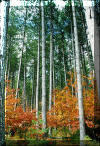 Pine Plantation |
|
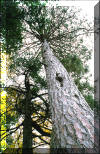 Old Red Pine |
| WHITE
PINE - 5 Sites
With a little practice, white pine’s silhouette can be identified while driving down the highways. The upper branches often grow irregularly away from the prevailing wind direction, giving the tree a wind swept appearance. The upper trunk of mature trees is light gray, perhaps lending itself the name "white pine". Abundant in the Upper Peninsula, white pine grows well on a wide variety of sites: from sandy soils to clay soils, on dunes as well as mounds in swamps, and flood plains, on rock ridges and outcrops. White pine grows in nearly pure stands and in mixture with hardwoods, also with hemlock and red pine. White pine of the original Michigan forests grew to be 200 to 250 years old, with trunks 6 ft. in diameter and a height of 250 feet! Today, trees are harvested at 80-100 years when they measure from 12-20 inches in diameter and are about 100 feet tall. White pine reproduces readily from seed carried as far as 1/4 mile in the wind, when released from the cone. Natural regeneration of white pine seedlings is sometimes limited due to its susceptibility to white pine blister rust fungus, the white pine weevil and over-browsing by deer. Timber harvesting leaves overstory "seed" trees standing throughout an area to protect an adequate seed supply to start a new stand for the next generation. White pine will also be one of the first trees to regenerate following a fire. It is also shade tolerant enough to establish itself in the understory of stands of red pine, jack pine and red, white and black oaks, and will gradually replace them as the overstory.
|
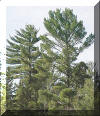 Emergent Crowns |
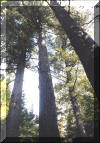 Mature Trees |
|
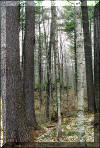 Mixed Stand |
| JACK
PINE - 12 Sites
Jack pine typically grows on sandy, poor soils in the U.P. It also tends to grow in stands of mixed species with quaking aspen, red pine and white pine. Jack pine is classified as a shade intolerant tree, requiring direct sunlight for proper growth. Due to this, it is necessary to perform partial or total clearcuts of a mature stand to regenerate the species to its most productive level. The cones of the jack pine open when exposed to intense heat from fire or direct sun after a heavy cutting. Once open, the cones release their seeds and germinate in the freshly exposed soil. Jack pine is a very valuable species to the forest products industry. It provides the woody material for products such as paper, chipboard and building materials. Without jack pine stands in the Upper Peninsula, the forest industry would be hard-pressed to meet the demands of the paper producing plants. The jack pine in the U.P. comes under attack by the jack pine budworm every 15 to 20 years. Along many of the highways you are traveling you may notice that some of the jack pine appears to be dying. This dieback may be due to a jack pine budworm infestation. The budworm chews up the needles of the jack pine and then nests on the branches. Once the tree is defoliated, it is unable to produce food and sustain itself. With a budworm outbreak, the amount of dead trees in the U.P. forest increases, creating a higher risk of fire.
|
 Managed Stands |
 Unmanaged Stand |
| NORTHERN
HARDWOODS - 29 Sites
Northern hardwood forests are usually harvested using a technique called single tree selection. A forester determines the correct amount of timber to be removed; marking the poorest trees with paint and then a logging crew cut the marked timber. Since the trees vary in age in size, they can be thinned every 15-20 years. The poor quality and larger, mature trees are removed, leaving the healthier and higher quality trees to grow for future harvests. A wide variety of wildlife species use this forest type, including many songbirds, black bear, white-tailed deer and hawks. Northern hardwood forests provide important habitat to a number of different warblers for feeding and nesting in the spring and summer months. One long time tradition of families throughout the U.P. is the "tapping" of sugar maple trees for maple syrup, both commercially and for family fun.
|
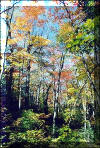 All-aged Stand |
 Overview |
| EASTERN HEMLOCK
- 6 Sites
Hemlock, though not as common as other Upper Peninsula trees, is usually found with white pine and yellow birch growing in cool, moist places. The wood from eastern hemlock is used for making paper or lumber. At one time, tannin from the bark was used in processing leather. Hemlock stands provide shelter essential for white-tailed deer in the winter. They also provide cover for ruffed grouse, rabbits and other animals. Management of hemlock for timber products is accomplished by thinning or a shelterwood harvest. Young stands are thinned to improve tree growth and quality. A shelterwood system may be used in older hemlock stands to regenerate new stands. This procedure occurs in two or three stages. The first stage thins the overstory trees to let light reach the forest floor to help young seedlings get started. Ten to twenty years later, the stand is thinned again to help the seedlings grow into saplings. Finally, when the young trees are 3 to 5 feet tall, the remaining overstory is removed. In the Upper Peninsula, you will see eastern hemlock growing in pure stands or mixed with other northern species. It is often found along streams or near lakes. The purplish brown bark of mature trees gives the hemlock a distinct appearance. These graceful trees with soft, "lacy" foliage can easily be picked out of the forest while driving down the highway.
|
| SPRUCE-FIR
- 8 Sites
These forests reseed themselves via lightweight seeds that are dispersed over great distances and reestablish after a fire. The spruce budworm, an insect that eats the needles of balsam fir and white spruce, is a serious pest in the spruce-fir cover type. After repeated annual defoliation, severe mortality in a forest stand occurs. This natural phenomenon has historically occurred in 20 to 30 year cycles. The death of large areas of trees then makes way for understory spruce and fir seedlings to grow into a new, healthy stand. Some people object to the unsightliness of many dead trees, half-broken and lying in a strewed pile. Yet, this is part of the spruce-fir system. Many birds, squirrels and other small ground animals use this forest type for food, eating the seeds, insects from the bark and the bark itself. People utilize the wood for pulpwood, lumber, furniture, interior trim and other household items. Indians once used the pliable roots of spruce for lacing birch bark canoes. Balsam fir is a popular Christmas tree because the needles do not fall off easily and it has a pleasant fragrance.
|
 Spruce-Fir Mix |
 Edge of Beaver Pond |
| CEDAR
- 14 Sites
The cedar swamp type often occurs in large areas of very dense trees. This makes it ideal habitat for wintering deer because it gives them shelter from extreme cold and deep snow. The thickness of the tree cover helps keep the snow depths lower compared to other areas where tree cover is more open. It also provides better thermal cover than open upland areas. Cedar browse is a nutritious food for deer in the winter. Management of this type of forest varies from clear-cuts, where trees are taken in narrow strips or patches to partial overstory removal (shelterwood). The forest products, such as cedar posts, cedar bolts for shingles, cabin logs and lumber, or mixed conifer pulpwood, are taken to the mills for processing. The adjoining or overstory trees left standing will seed in the cut over areas. Sometimes the harvest area is burned so the seeds have good soil contact. Cedar is extremely slow growing as a seedling, taking as much as 25-30 years to become established in the cool, damp swamp soils. Besides the taking of forest products, cutting helps provide deer browse (grazing food). Cedar can however, be over browsed by deer to the point that the deer (especially young deer) can no longer reach the food they so desperately need. This is what gives a cedar stand the distinct appearance that its been neatly pruned from the ground to about 5 feet up. Young stands will provide vital browse and eventually grow in to the dense thicket deer need for winter survival.
|
|
GRASS OPENINGS - 7 Sites
In the absence of fires and farming, the grass openings began to be slowly reclaimed by tree cover such as aspen, willow, alder, birch and jack pine. This accelerated in the 1930ís and is still taking place. Decades later you can still see treeless and grassy fields, often called savannas, just as they first appeared. Openings are beneficial to certain wildlife species. In the spring, these openings "green up" first, providing deer and other grazers with succulent grasses. A large opening is very appealing to hawks and many seed-eating birds. Prey species such as mice and voles are abundant. Species that are adapted to a prairie-like environment, sharp-tailed grouse and upland plovers are to be found feeding on insects and seeds. The ritualistic spring mating flight and dance of the American woodcock is dependent upon mixed brush-grass openings. You can find the following species in most northern, large openings: red-tailed hawk, eastern bluebird, American kestrel, meadow vole, smooth green snake, coyote and many more. Foresters, wildlife biologists and other resource people manage large openings for their historical, scenic, and wildlife benefits. Prescribed (controlled) burning is one way to establish and/or maintain openings and keep this valuable resource.
|
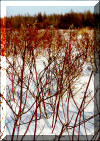 |
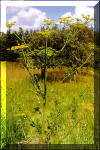 |
|
 |
|
FIRE IMPORTANCE - 3 Sites
Today, prescribed fire is occasionally used in forest practices, such as forest regeneration, wildlife management, blueberry production and controlling species invasion. Two recent wildfire sites for you to see are: U.S. 2, STONINGTON FIRE The Stockyard Fire burned in 1988 and consumed approximately 1400 acres. The standing dead trees, many of them jack pine (snags) that could not be salvaged, remain standing as a reminder of the damage caused by accidental or purposely set wildfires. Despite the destruction, some species of wildlife have taken up residence. Notice the natural jack pine seedlings. This is one tree species that regenerates well after fires. The fire reduces ground vegetation, exposes mineral soils and causes the tightly bound (serotinous) pine cones in the standing snags to open and scatter their seed. M-28, SENEY FIRE This lightning caused wildfire, burned 74,000 acres in the drought year of 1976. It became one of the largest fires in Michigan history. Today it is hard to see where the fire jumped M-28 except for a few remaining dead trees. On aerial photographs, only a few fire control lines are visible. Despite the amount of land burned, this area shows a variety of trees that have naturally regenerated such as aspen, red, white and jack pine. Abundant wildlife has taken up residence as well.
|
 Prescribed Burn |
 Stonington-2002 |
| OLD
GROWTH - 6 Sites
Like people, trees have no defined life span. In an old growth forest, the trees have reached maturity and have begun to die. From that point on, the large trees decline as the effects of aging set in. In a forest stand, this means that the trees begin to lose their commercial value. People value old growth forest for a variety of reasons. These can include a source for rare species, both animal and plant, a piece of history, and recreation. Despite personal reasons for preserving or cutting old growth forests, they have been shown to have their place in the forest ecosystem.
|
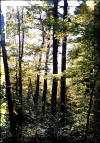 Estivant Tract |
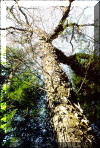 Yellow Birch |
|
 Sylvania Tract |

![]() TOP
Press arrow to return to the top of this page.
TOP
Press arrow to return to the top of this page.

This website is maintained by Bill Cook, Michigan State University Extension
Forest in the Upper Peninsula. Comments, questions,
and suggestions are gratefully accepted.
Last update of this page
was 21 September, 2005
This site is hosted by School of Forest Resources and Environmental Science at Michigan Technological University.